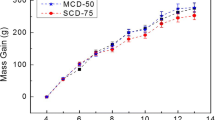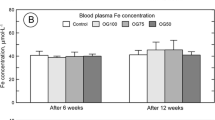Abstract
Different coloured, fluorescent bone-seeking chemicals, viz., tetracycline, Alizarin Red S, and DCAF, have been administered sequentially to weanling rats and the rate of formation and resorption of bone measured from hard-ground cross sections of the upper third of the diaphysis of the femur. On a meat diet, bodily growth is significantly restricted for the first week and then recovery occurs. While bones grow they fail to mineralize normally and rapidly become fragile and rarefied. Resorption of bone is at first slow, then accelerates for a period of 2–3 weeks to about 15μ/day and then slows again. While the rate of bone formation is reduced relative to normal bone, resorption proceeds at approximately two to three times the rate of bone growth. Microradiographic studies confirm tht while resorption occurs on the endosteal margin and formation proceeds on the periosteal aspect of meat fed Ca-deficient rats, new bone is less calcified than that in control animals.
Résumé
Divers agents chimiques, colorés, fluorescents et se localisant dans les os, à savoir la tétracycline, l'alazazine rouge S et le DCAF, ont été administré en série à des rats sevrés et on a mesuré le taux de la formation et de la résorption osseuse sur les coupes transversales du tiers supérieur de la diaphyse. Ici la formation osseuse périostale s'effectue progressivement avec peu de changement endostéal. Avec alimentation carnée, la croissance des rats est significativement restreinte pendant la première semaine, mais se rétablit ensuite. Bien qu'il y ait croissance des os, ceux-ci ne se minéralisent pas normalement et ils deviennent rapidement fragiles et amincis. La résorption osseuse est lente d'abord, puis s'accelère pendant 2–3 semaines pour atteindre un taux de 15μ par jour, après quoi elle se ralentit de nouveau. Bien que le taux de formation osseuse soit réduit, en comparaison avec celui des os normaux, la résorption s'effectue environ deux à trois fois plus rapidement que la croissance osseuse. Des études microradiographiques sur des rats à régime carné mais carencés en calcium ont permis la constatation suivante: tandis que la résorption s'effectue à la marge endostéale et que la formation osseuse a lieu sur l'aspect périostéal, la matière osseuse nouvellement formée est moins calcifiéc que chez les témoins.
Zusammenfassung
Einige farbige, fluoreszierende, knochensuchende Chemikalien, z. B. Tetracyclin, Alazarin-Rot S und CDAF, wurden nacheinander an entwöhnten Ratten verabreicht, worauf man die Knochenbildungs- und Knochenresorptionswerte an hartgeschliffenen Schnitten des oberen Drittels der Diaphyse gemessen hat. Hier findet fortschreitend periostale Knochenbildung statt, mit geringer Veränderung des Endosteums. Bei Fleischdiät wird das Körperwachstum während der ersten Woche erheblich beschränkt; danach aber normalisiert es sich wieder. Obwohl die Knochen noch wachsen, zeigen sie keine normale Mineralisierung und werden schnell zerbrechlich und dünn. Die Knochenresorption ist anfangs langsam, dann beschleunigt sie sich während einer Zeitspanne von 2–3 Wochen bis auf 15 μ pro Tag, um sich dann wieder zu verlangsamen. Während die Knochenbildungsgeschwindigkeit relativ zum Normalwert heruntergesetzt wird, verläuft die Resorption ungefähr 2–3mal so schnell wie die Knochenbildung. Mikroradiographische Untersuchungen an mit Fleisch ernährten Ca-armen Ratten haben bestätigt, daß während die Resorption am Endosteumrande stattfindet und sich die Knochenbildung an der Periostenfläche fortsetzt, die neugebildete Knochensubstanz weniger kalzifiziert ist, als die der Kontrolltiere.
Similar content being viewed by others
References
Amprino, R., Marotti, G.: A topographic quantative study of bone formation and reconstruction. In: Bone and tooth, ed. H. J. J. Blackwood, p. 21–33. Oxford: Pergamon Press 1964.
Arnold, J. S., Jee, W. S. S.: Bone growth and osteoclastic activity as indicated by radio-autographic distribution of plutonium. Amer. J. Anat.101, 367–418 (1957).
Bauer, G. C. H., Carlsson, A., Lindquist, B.: Accretion rate of bone salt in osteoporosis studied by means of P32. Acta med. scand.158, 139–142 (1957).
Belanger, L. F., Robichon, J., Migicovsky, B. B., Copp, D. H., Vincent, J.: Resorption without osteoclasts (osteolysis). In: Mechanisms of hard tissue destruction, ed. R. F. Sognnaes, p. 531–556. Washington: Amer. Ass. Adv. Science 1963.
Belchier, J.: An account of the bones of animals being changed to a red colour by ailment only. Phil. Trans.34, 287–299 (1736).
Bohr, H.: Chemical analyses and microradiographic investigations on bone biopsies from cases of osteoporosis and osteomalacia as compared with normal. Part. II. Microradiographic studies in normal, osteoporotic and osteomalacic bone. In: Bone and tooth, ed. H. J. J. Blackwood, p. 405–409. Oxford: Pergamon Press 1964.
Brash, J. C.: The growth of the alveolar bone and its relation to the movements of the teeth, including eruption. Dent. Rec.46, 641–664 (1926).
Copp, D. H., Sucker, A. P.: Study of calcium kinetics in calcium — and phosphorusdeficient rats with the aid of radiocalcium. In: Radioisotopes and bone, ed. P. Lacroix and A. M. Budy, p. 1–15. Oxford: Blackwell 1962.
Crawford, J., Gribetz, D., Diner, W. C., Hurst, P., Castleman, B.: The influence of vitamin D on parathyroid activity and the metabolism of calcium and citrate during calcium deprivation. Endocrinology61, 59–71 (1957).
Dollerup, E.: Chemical analyses and microradiographic investigations on bone biopsies from cases of osteoporosis and osteomalacia as compared with normal. Part I. Calcium, phosphorus and nitrogen content of normal and osteoporotic human bone. In: Bone and tooth, ed. H. J. J. Blackwood, p. 399–404. Oxford: Pergamon Press 1964.
Fell, H. B.: Some factors in the regulation of cell physiology in skeletal tissues. In: Bone biodynamics, ed. H. M. Frost, p. 189–207. Boston: Little, Brown & Co. 1964.
Fiske, C. H., Subbarow, Y.: The colorimetric determination of phosphorus. J. biol. Chem.66, 375–400 (1925).
Fullmer, H. M., Link, C. C., Jr., Baer, M. J.: A stain for bone—illustrating apposition and absorption in two colours. Stain Technol.39, 71–73 (1964).
Goldhaber, P.: Behaviour of bone in tissue culture. In: Calcification in biological systems, ed. R. F. Sognnaes, p. 349–372. Washington: Amer. Ass. Adv. Science 1960.
Hancox, N.: The osteoclast. In: The biochemistry and physiology of bone, ed. G. H. Bourne, p. 213–250. New York-London: Academic Press 1956.
Harrison, G. E.: Estimation of strontium in biological materials by means of a flame spectrophotometer. Nature (Lond.)182, 792–793 (1958).
Harrison, M., Fraser, R.: Bone metabolism in rats, studied with stable strontium. J. Endocr.21, 191–205 (1960).
Heaney, R. P.: Interpretation of calcium kinetic data. In: Dynamic studies of metabolic bone disease, eds. O. H. Pearson and G. F. Joplin, p. 11–23. Oxford: Blackwell 1964.
Howship, J.: Experiments and observations in order to ascertain the means employed by animal economy in the formation of bone. Med. chir. Trans.6, 263–295 (1815).
Hunter, J. (1798): Experiments and observations on the growth of bones: In Hunter's works (D. F. Palmer's Edition), p. 315. London: Longman's 1837.
Johnson, L. C.: Morphologic analysis in pathology: the kinetics of disease and general biology of bone. In: Bone biodynamics, ed. H. M. Frost, p. 543–654. Boston: Little, Brown & Co. 1964.
Jowsey, J., Sissons, H. A., Vaughan, J.: The site of deposition of Y91 in the bones of rabbits and dogs. J. nucl. Energy2, 168–176 (1956).
—: Age changes in human bone. Clin. Orthop.17, 210–218 (1960).
—: Microradiography of bone resorption. In: Mechanisms of hard tissue destruction, ed. R. F. Sognnaes, p. 447–469. Washington: Amer. Ass. Adv. Science 1963.
—, Raisz, L. G.: Experimental osteoporosis and parathyroid activity. Endocrinology82, 384–396 (1968).
Klein, L., Lafferty, F. W., Pearson, O. H., Curtiss, P. H., Jr.: Correlation of urinary hydroxyproline, serumalkline phosphatase and skeletal calcium turnover. Metabolism13, 272–284, 1964.
Kölliker, A. von: Die normale Resorption des Knochengewebes und ihre Bedeutung für die Entstehung der typischen Knochenformen. Leipzig: F. C. W. Vogel 1873.
Leblond, C. P., Wilkinson, G. W., Belanger, L. F., Robichon, J.: Radio-autographic visualization of bone formation in the rat. Amer. J. Anat.,86, 289–341, (1950).
Milch, R. A., Rall, D. P., Tobie, J. E.: Bone localization of the tetracyclines. J. nat. Cancer Inst.19, 87–93 (1957).
Nordin, B. E. C.: The application of basic science to osteoporosis. In: Bone biodynamics, ed. H. M. Frost, p. 521–542. Boston: Little, Brown & Co. 1964.
Rowland, R. E.: Resorption and bone physiology. In: Bone biodynamics, ed. H. M. Frost, p. 335–351. Boston: Little, Brown & Co. 1964.
Scott, P. P., Greaves, J. P., Scott, M. G.: Nutrition of the cat. 4. Calcium and iodine deficiency on a meat diet. Brit. J. Nutr.15, 35–51 (1961).
Storey, E.: Bone changes associated with cortisone administration in the rat. Effect of variations in dietary calcium and phosphorus. Brit. J. exp. Path.41, 207–213 (1960).
—: Cortisone-induced bone resorption in the rabbit. Endocrinology68, 533–542, (1961).
Suzuki, H. K., Mathews, A.: Two-color fluorescent labeling of mineralizing tissues with tetracycline and 2,4-Bis[N,N′-di-(Carbomethyl) aminomethyl]fluorescein. Stain Technol.41, 57–60 (1966).
Urist, M. R., Deutsch, N. M.: Effects of cortisone upon blood, adrenal cortex, gonads, and the development of osteoporosis in birds. Endocrinology66, 805–818 (1960).
Sluys Veer, J., van de, Smeenk, D., Heul, R. O., van der: Tetracycline labelling of bone in hyperparathyroidism. In: Bone and tooth, ed. H. J. J. Blackwood, p. 85–91. Oxford: Pergamon Press 1964.
Williamson, M., Vaughan, J.: A preliminary report on the sites of deposition of Y, Am and Pu in cortical bone and in the region of the epiphyseal cartilage plate. In: Bone and tooth, ed. H. J. J. Blackwood, p. 71–83. Oxford: Pergamon Press 1964.
Young, R. W.: Histophysical studies on bone cells and bone resorption. In: Mechanisms of hard tissue destruction, ed. R. F. Sognnaes, p. 471–496. Washington: Amer. Ass. Adv. Science 1963.
Author information
Authors and Affiliations
Rights and permissions
About this article
Cite this article
Hammond, R.H., Storey, E. Measurement of growth and resorption of bone in rats fed meat diet. Calc. Tis Res. 4, 291–304 (1969). https://doi.org/10.1007/BF02279132
Issue Date:
DOI: https://doi.org/10.1007/BF02279132




